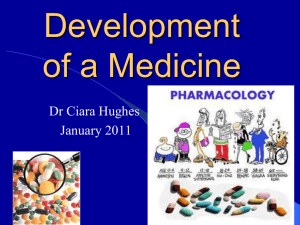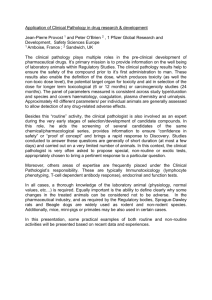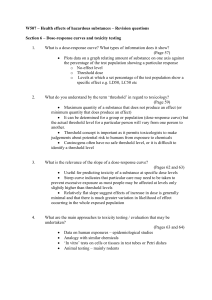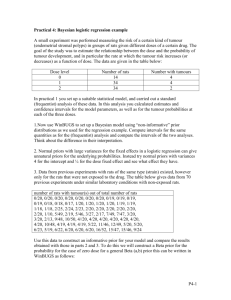Safety assessment of Diabecon: An ayurvedic formulation in
advertisement
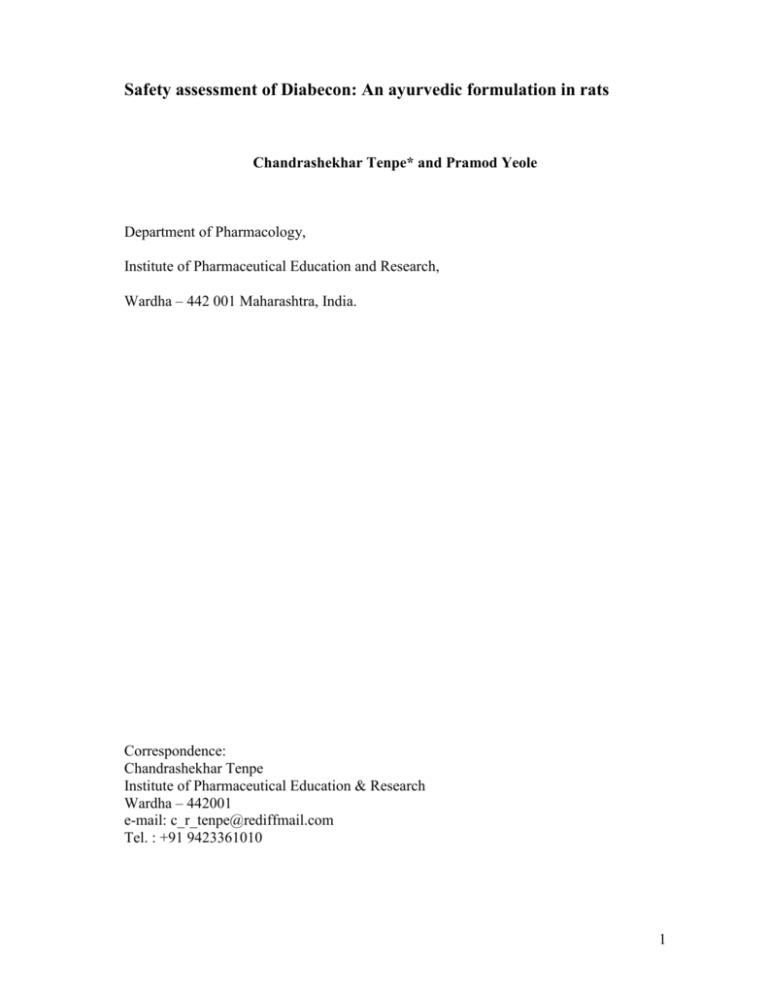
Safety assessment of Diabecon: An ayurvedic formulation in rats Chandrashekhar Tenpe* and Pramod Yeole Department of Pharmacology, Institute of Pharmaceutical Education and Research, Wardha – 442 001 Maharashtra, India. Correspondence: Chandrashekhar Tenpe Institute of Pharmaceutical Education & Research Wardha – 442001 e-mail: c_r_tenpe@rediffmail.com Tel. : +91 9423361010 1 Abstract Diabecon an ayurvedic formulation was tested for safety by estimation of heavy metal contents and also for acute and sub chronic toxicity. Heavy metal content in formulation were tested and found to be within limit as prescribed by WHO. In acute toxicity no toxic symptoms were seen at single oral dose of 2000 mg/kg, observed up to 14 days in rats. In sub chronic toxicity study, Diabecon was tested at the doses of 50, 250 and 500 mg/kg p.o. once daily for 90 days in rats. The results did not show evidence of any treatment related changes in body weight, food and water intake and ill health or behavioral changes, when compared with the control animals. Some significant changes were observed in high dose treatment group (500 mg/kg) in hematological and serum chemistry parameters compared to control group but were within the normal laboratory limit and were considered as incidental. Key Words: Diabecon; Heavy metals; acute toxicity; sub chronic toxicity. 2 Introduction Natural products, including plants, animals and minerals have been the basis of treatment of human diseases. History of medicine dates back practically to the existence of human civilization. The current accepted modern medicine or allopathy has gradually developed over the years by scientific and observational efforts of scientists. However, the basis of its development remains rooted in traditional medicine and therapies (Patwardhan and Hooper, 1992). Ayurveda, the ancient healing of India recommends a combination of lifestyle management (which includes diet, exercise and medication), and treatment with specific herbs and minerals to cure various diseases. Ayurvedic preparations may contain the aqueous extracts or powders of the different parts of the plants (Edwin et al., 2008). Along with herbs some preparations may contain animal-derived products and minerals. Global resurgence of Ayurveda especially its herbal component has led to the need of its scientific validation both in terms of efficacy and safety. Within this system, in particular, are plants that lack ethno medical verification of efficacy or safety. Unfortunately there is no universal regulatory system in place that insures that any of these plant remedies are what they say they are, do what is claimed, or most importantly are safe (Memory, 2001). Major hindrance in amalgamation of herbal medicine in modern medical practices is lack of scientific and clinical data proving their efficacy and safety (Modak et al., 2007). Though Herbal medications are claimed and widely believed to be beneficial; however, there have been reports of acute and chronic intoxications resulting from their use (Chan, 2003; Poppenga, 2002). The popularity and availability of the traditional remedies have generated concerns regarding the safety, efficacy and responsibility of practitioners using traditional remedies. The clinical manifestations of metal poisoning have also been well 3 characterized (Ernst, 2002; Obi et al., 2006). Thus, the screening of traditional remedies for safety has become necessary to protect public health. The objective of the present study was to investigate the safety of Diabecon, an ayurvedic preparation used in the treatment of Diabetes mellitus by estimation of heavy metal contents and also for acute and sub chronic toxicity. Materials and Methods Formulation and reagents Ayurvedic formulation Diabecon used in the study was purchased from the retail chemist and available in the form of tablet (Batch No. AO 38027, Manufactured by The Himalaya Drug Company, Bangalore). The composition of formulation as appeared on the label, contains Guggul (purified) (Balsamodendron mukul) 30mg, and Shilajeet (purified) 30mg, extracts of: Meshashringi (Gymnema sylvestre) 30mg, Pitasara (Pterocarpus arsupium) 20mg, Yashti-madhu (Glycyrrhiza glabra) 20mg, Saptarangi (Casearia esculenta) 20mg, Jambu (Eugenia jambolana) 20mg, Shatavari (Asparagus racemosus) 20mg, Punarnava (Boerhaavia diffusa) 20mg, Mundatika (Sphaeranthus indicus) 10mg, Guduchi (Tinospora cordifolia) 10mg, Kairata (Swertia chirata) 10mg, Gokshura (Tribulus terrestris) 10mg, Bhumyaamlaki (Phyllanthus amarus) 10mg, Gumbhari (Gmelina arborea) 10mg, Karpasi (Gossypium herbaceum) 10mg, Daru haridra (Berberis aristata) 5mg, Kumari (Aloe vera) 5mg, and Triphala 3mg and powders: Sushavi (Momordica charantia) 20mg, Maricha (Piper nigrum) 10mg, Vishnu priya (Ocimum sanctum) 10mg, Atibala (Abutilon indicum) 10mg, Haridra (Curcuma longa) 10mg, Jungli palak (Rumex maritimus) 5mg, Vidangadi lauham 27mg, Vang bhasma 5mg, Abhrak bhasma 10mg, Praval bhasma 10mg, Akik pishti 5mg, Shingraf 5mg, Yashad 4 bhasma 5mg and Trikatu 5mg. Diagnostic kits used for the estimation of serum chemistry parameters were obtained from Merk Specialities Private Limited, Mumbai, India. Animals Albino rats of Wistar strain (100 – 160 g body weight) of either sex, procured from inhouse animal facility of Institute of Pharmaceutical Education and Research, Wardha, India. All animals were housed under standard conditions of temperature 25±20C, 65±10% relative humidity, 12:12 hr Light : Dark cycle and fed with standard pellet diet (Trimurti foods, Nagpur, India) and water ad libitum. Experimental protocols were approved by Institutional animal ethics committee (Registration No. 535/02/a/CPCSEA/Jan 2002) of Institute of Pharmaceutical Education and Research, Wardha, India. Estimation of Heavy metal in formulations Estimation of heavy metals Lead, Arsenic, Cadmium and Mercury was done by Atomic absorption spectrometry in Qualichem Laboratories, Nagpur, India. Acute oral toxicity study Five nulliparous and non pregnant female rats of 4 to 5 weeks age were randomly selected. They were treated with aqueous suspension of finely powdered Diabecon at 2,000 mg/kg body weight as a single oral dose. The animals were observed for morbidity and mortality at 1, 2, 4, and 6 hr on the day of dosing and once a day thereafter up to 14 days. The body weights were recorded individually on day 0, 7th and on 14th day. The study was performed in accordance with Organisation for Economic Co-operation and Development (OECD) test guideline No.420 (2000). Sub-chronic oral toxicity study 5 A 90 days repeated dose oral toxicity study was conducted to evaluate the toxic effects (if any) of Diabecon. This study was performed in accordance with the OECD test guideline No. 408 (1998). Wistar rats (100 – 160 g b.w.) were housed five in each cage. The animals were randomly divided into four groups I to IV of 10 rats each (five females and five males). Chronic toxicity was evaluated after single daily administration of test drug at therapeutic dose 50 (Low), 250 (Medium, 5 times therapeutic dose) and 500 mg/kg (High, 10 times therapeutic dose). Therapeutic dose for rat was calculated considering the differences in surface area: body weight ratio between human and rat (Tweats, 2006). Animals were observed daily for mortality and appearance of any signs of intoxication. Body weights and food consumption were recorded at initiation and thereafter every 15 days, up to 90 days treatment period. Blood samples were collected from the retro-orbital sinuses of all rats and hematological and serum chemistry investigations performed, following 90 days of Diabecon treatment. Hematological parameters investigated includes red blood corpuscles (RBC), Hemoglobin (Hb), hematocrit (HCT), mean corpuscular hemoglobin (MCH), mean corpuscular hemoglobin concentration (MCHC), white blood cells (WBC) and platelets (PLT) on auto cell counter (Medonic SE-12613, Sweden). Serum chemistry evaluations were performed to determine the levels or activity for glucose, cholesterol, triglycerides, alkaline phosphatase (AP), alanine aminotransferase (ALT), aspartate aminotransferase (AST), albumin, creatinine, total protein and urea using specific kits on semi automated clinical analyzer (Merk Microlab300). Statistical analysis Statistical analysis was performed on GraphPad InStat Software. All values are reported as mean ± S.D. The one-way ANOVA followed by the Dunnett’s t test was used to 6 compare mean differences of the control and the treated rats, with p<0.05 set as the level of significance. Results Heavy metals The content of heavy metal Lead (Pb), Arsenic (As), Cadmium (Cd) and Mercury (Hg) in ayurvedic formulation, Diabecon was found to be 1.08, 0.9, 0.0, and 0.55 ppm respectively. All heavy metal were within permissible limits as laid down by Guidelines for Quality standerdised herbal formulations, WHO (2004). Acute toxicity study Diabecon at single oral dose of 2000 mg/kg, did not produce any mortality and did not reveal any abnormal clinical signs and body weight changes during the study period of 14 days. Necropsy at the end of the study did not reveal any gross pathological abnormalities in rats. Sub chronic toxicity study All animals survived until the 90 days treatment period. No signs of clinical toxicity attributable to Diabecon were observed throughout the study and no significance differences on body weight gain were observed between treated and control groups (Figs. 1 and 2). Some statistically significant differences were noted in hematological (Table 1) and serum chemistry (Table 2) parameters when the control and treatment groups were compared. 7 160 Body Weight (g) 150 140 0 mg/kg 50 mg/kg 130 250 mg/kg 500 mg/kg 120 110 100 0 15 30 45 60 75 90 Num ber of Days Fig. 1. Mean body weights for female rats during a 90 days oral sub chronic toxicity study. 170 Body Weight (g) 160 150 0 mg/kg 140 50 mg/kg 250 mg/kg 130 500 mg/kg 120 110 100 0 15 30 45 60 75 90 Num ber of Days Fig. 2. Mean body weights for male rats during a 90 days oral sub chronic toxicity study. 8 Table 2. Effects of Diabecon on hematological parameters in rats after 90 days period of daily intake Parameter Units mg/kg/day _________________________________________________ 0 50 250 500 Female RBC 106/mm3 8.02±0.07 7.75±0.77 7.60±0.67 8.06±0.74 HGB G% 13.86±0.84 13.80±0.78 13.56±0.72 13.72±0.79 HCT % 47.35±3.87 48.41±3.65 49.52±3.40 45.21±4.79 MCV fL 59.40±3.85 57.76±7.64 58.80±5.69 61.12±5.06 MCH Pg 16.74±1.33 16.62±1.58 16.62±1.38 16.50±1.45 MCHC % 33.87±4.22 31.88±5.67 29.28±2.05 31.94±3.48 WBC 103/mm3 9.96±1.71 9.94±2.25 10.51±1.44 12.90±0.67* 3 3 PLT 10 /mm 626.1±78.64 659.2±94.99 643.6±94.92 699.6±92.26 Male RBC 106/mm3 8.09±0.49 7.39±0.97 7.98±0.62 7.40±0.40 HGB G% 14.18±0.59 14.22±0.48 13.90±0.58 14.14±0.35 HCT % 48.65±3.96 46.28±6.20 45.63±4.26 45.59±4.08 MCV fL 60.46±6.83 61.28±2.52 57.90±4.82 58.20±6.20 MCH Pg 16.78±1.29 17.10±0.95 15.02±0.70* 17.06±0.88 MCHC % 32.18±5.85 32.72±5.14 34.58±4.26 33.12±4.81 3 3 WBC 10 /mm 10.95±1.79 10.13±1.89 10.39±2.38 10.79±2.54 PLT 103/mm3 641.8±66.21 622.7±96.06 667.6±97.43 685.2±98.21 Values are mean ± SD for 5 rats in each group. *p<0.05; RBC = Red blood corpuscles; HGB = Hemoglobin; HCT = Hematocrit; MCV = Mean corpuscular volume; MCH = Mean corpuscular hemoglobin; MCHC = Mean corpuscular hemoglobin concentration; WBC = White blood cells; PLT = Platelets. 9 Table 2. Effects of Diabecon on serum chemistry parameters in rats after 90 days period of daily intake Parameter Units mg/kg/day _________________________________________________ 0 50 250 500 Female Glucose mg/dl 80.20±4.97 80.20±3.49 76.60±3.91 72.00±7.31 Cholesterol mg/dl 96.80±9.55 96.60±11.55 85.20±10.26 77.0±8.72* Triglycerides mg/dl 87.80±7.63 85.60±7.89 85.40±5.08 86.60±8.82 ALP IU/L 120.6±10.6 124.0±18.34 120.0±10.37 120.0±17.13 ALT IU/L 70.40±10.06 69.20±14.25 62.40±11.10 73.80±8.61 AST IU/L 139.4±9.37 133.4±15.84 134.0±6.71 158.8±5.81* Albumin g/dl 3.81±0.22 3.85±0.29 3.92±0.31 3.97±0.33 Creatinine mg/dl 1.00±0.15 0.95±0.26 1.00±0.23 0.89±0.09 Total Protein g/dl 6.72±0.61 7.02±0.67 6.90±0.60 7.03±0.54 Urea mg/dl 32.39±4.74 35.22±4.55 34.58±7.06 33.10±5.44 Male Glucose mg/dl 82.60±5.77 82.60±3.97 77.60±5.13 71.20±3.49** Cholesterol mg/dl 101.6±4.16 96.80±10.18 91.60±7.23 69.40±2.79 Triglycerides mg/dl 89.20±6.61 82.40±8.88 86.40±11.0 75.00±9.22 ALP IU/L 131.4±11.52 123.4±17.57 124.4±12.97 120.0±16.96 ALT IU/L 70.00±10.70 69.60±12.88 67.20±5.76 70.80±4.32 AST IU/L 134.0±9.03 132.6±10.83 131.6±14.91 137.0±9.22 Albumin g/dl 3.81±0.30 3.75±0.25 3.85±0.12 3.76±0.27 Creatinine mg/dl 1.03±0.22 0.72±0.13** 0.91±0.09 0.93±0.09 Total Protein g/dl 6.74±0.75 6.28±0.38 6.50±0.61 7.12±0.59 Urea mg/dl 34.51±4.43 35.98±2.25 34.02±6.17 37.76±3.39 Values are mean ± SD for 5 rats in each group. *p<0.05 and **p<0.01; ALP : Alkaline phosphatase; ALT : Alanine aminotransferase; AST : Aspartate aminotransferase 10 Discussion Heavy metals lead, mercury, cadmium and arsenic on subcellular organelle systems following in vivo administration has been found to interfere with normal cellular replication and genetic processes (Fowler, 1978). Heavy metal toxicity following the use of Ayurvedic remedies is well documented in the literature. During the traditional preparation of bhasmas the metal is “purified-out” through multiple cooling and heating cycles and by addition of specific “mineral herbs.” In modern formulations, however, the concentration of heavy metals may be excessive because poor quality control allows for contamination, adulteration, or improper purification (Lynch and Braithwaite, 2005). The Govt. of India – Dept. of AYUSH – Ministry of health and family welfare has issued new safety standards. There is the mandatory testing for heavy metals in every batch of ayurvedic herbs manufactured by all licensees for all exporting purposes. The permissible limit of heavy metals in ayurveda with herbal ingredients is lead: 10, cadmium: 0.30 arsenic: 10 and mercury: 1 ppm. In Diabecon the levels of heavy metals were found to be within the prescribed limit. Assessment of acute oral toxicity of a test substance forms the primary step in the characterization of its toxic potential. Different test methods have been devised by OECD for acute toxicity evaluation. Taking into account this background, Diabecon was tested on acute oral exposure as per OECD guideline 420-Fixed dose procedure that utilizes non-lethal endpoints to determine the toxicity of the test material. At dose level of 2000 mg/kg of body weight, Diabecon did not exhibit any lethality or toxic symptoms. All animals were free of intoxication signs throughout the period of study. Gross pathology examination of animals sacrificed at the end of the study revealed no abnormalities. According to the Globally Harmonized System (GSH) for the classification of substances 11 which cause acute toxicity, ayurvedic formulation Diabecon can be classified in the hazard category 5 or unclassified with a LD50 higher than 2000 mg/kg. Repeated dose toxicity studies was conducted to evaluate the adverse effects of Diabecon after prolonged use and were carried out to provide information about the possible health hazards likely to arise from repeated exposure over a relatively limited period of time, the possibilities of cumulative effects, and an estimate of the dose at which there is no observed adverse effect. It has been well established that a repeated dose toxicity study, with exposure at lower dosage levels mimics such human exposure and reveals the likely effects of such low exposure levels (Allan et al., 2007). The sub chronic study was performed according to a well designed protocol based on the OECD Guidelines for Testing Chemicals, Health Effects Test Guidelines, for Repeated Dose 90-Day Oral Toxicity Study in Rodents, Section 408. Based on the results of acute toxicity studies and taking in to consideration the reported clinical dose, dose levels of 50(Low), 250(Medium) and 500(High) mg/kg body weight were selected for the sub-chronic oral toxicity study. Significant changes in body weight were noted at 45 day in the male 500 mg/kg group compare to vehicle treated (p<0.05). However the change was judge to be incidental. No significant changes in body weight were observed in the female 50, 250 or 500 mg/kg groups, or in the male 50 and 250 mg/kg groups. All animals from these groups exhibited weight gain comparable to vehicle control group as shown in Fig. 1 and 2. There was no mortality; no significant changes in feed consumption and no any treatment related ill health or behavioral changes or reactions were noted in all groups related to Diabecon administration, up dose level of 500 mg/kg p.o. for 90 days (Data not shown). At the end of 90 days there were no treatment-related adverse effects of formulation on hematology parameters in male 12 and female rats with Diabecon. However, in male group (250 mg/kg) a significant decrease in mean values of mean corpuscular hemoglobin was noted (p<0.05) and in female group (500 mg/kg) significant increase in mean values of white blood cell were noted (p<0.05) when compared with control group. The change was considered as incidental and not treatment-related because of the lack of dose dependency. No significant changes in other hematology parameters in this group and in the female 50 and 250 mg/kg groups, or in the male 50, and 500 mg/kg groups were observed as shown in Table 1. Results of serum chemistry investigations in female and male group after 90 days treatment with Diabecon are shown in Table 2. Glucose decrease significantly in the male 500 mg/kg group compared to control group (p<0.01). This may be due to dose dependent hypoglycemic effect. Cholesterol level was significantly decreased in female 500 mg/kg group (p<0.05) and creatinine level was significantly decrease in male 50 mg/kg group (p<0.01). AST was significantly elevated in female 500 mg/kg group compared to control animals (p<0.05). All significant changes in serum chemistry parameters of treatment groups were within the normal laboratory limit and were considered as biological variations and not toxic effects of Diabecon. No statistically significant changes were detected in any of the other parameters in these groups and other female (50 and 250 mg/kg) and male (250 mg/kg) groups. Conclusion The present study confirms that heavy metal in ayurvedic formulation Diabecon was within limit. The high LD50 value (>2000 mg/kg) obtained was a clear indication that Diabecon could be safe for use. The 90-day sub-chronic study showed no treatmentrelated adverse events, demonstrating that the formulation Diabecon is non-toxic to rats, with a NOAEL (no observed adverse effect level) of 500 mg/kg/day when administered 13 orally for 90 consecutive days. However some statistically significant changes were observed in some serum chemistry parameters which may be incidental. Hence to conclude present study suggests that Ayurvedic formulation Diabecon is safe and no drug-related toxicity was detected even at the highest doses investigated in both acute (2000 mg/kg) and sub chronic (500 mg/kg) studies. Conflict of interest The authors declare that there are no conflicts of interest. 14 REFERENCES Allan JJ, Damodaran A, Deshmukh NS, Goudar KS, Amit A. Safety evaluation of a standardized phytochemical composition extracted from Bacopa monnieri in SpragueDawley rats. Food and Chemical Toxicology. 2007; 45(10): 1928-37. Chan K. Some aspects of toxic contaminats in herbal medicines. Chemosphere. 2003; 52: 1361-71. Edwin J, Joshi SB, Jain DC. Diabetes and Herbal Medicines. Iranian Journal of Pharmacology and Therapeutics. 2008; 7(1): 97-106. Ernst E. Toxic heavy metals and undeclared drugs in Asian herbal medicines. TRENDS in Pharmacological Sciences. 2002; 23(3): 136-39. Fowler BA. General subcellular effects of lead, mercury, cadmium and arsenic. Environ. Health Perspect. 1978; 22: 37-41. Lynch E, Braithwaite, R.. A review of the clinical and toxicological aspects of ‘traditional’ (herbal) medicines adulterated with heavy metals. Expert Opin. Drug Saf. 2005; 4(4): 769-78. Memory EL. Should we be concerned about herbal remedies. Journal of Ethnopharmacology. 2001; 75: 141–164. 15 Modak M, Dixit P, Londhe, J, Ghaskadbi S, Thomas PA. Indian Herbs and Herbal Drugs Used for the Treatment of Diabetes. J. Clin. Biochem. Nutr. 2007; 40(3): 163–73. Obi E, Akunyili DN, Ekpo B, Orisakwe. Heavy metal hazards of Nigerian herbal remedies. Science of the Total Environment. 2006; 369: 35-41. Patwardhan B, Hooper M. Ayurveda and future drug development. Int. J. Alternative Complement Med. 1992; 10(2): 9-11. Poppenga RH. Herbal Medicine: Potential for Intoxication and Interactions with Conventional Drugs. Clinical Techniques in Small Animal Practice. 2002; 17(1); 6-18. Tweats DJ. Preclinical safety testing, in: Griffin, J.P., Grady, J.O. (Eds.), The text book of Pharmaceutical Medicine. New Age International Publisher, New Delhi, 2006, pp. 111-141. 16


